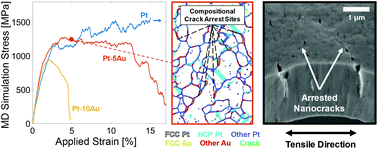New nanoscale toughening mechanisms mitigate embrittlement in binary nanocrystalline alloys†
Abstract
Nanocrystalline metals offer significant improvements in structural performance over conventional alloys. However, their performance is limited by grain boundary instability and limited ductility. Solute segregation has been proposed as a stabilization mechanism, however the solute atoms can embrittle grain boundaries and further degrade the toughness. In the present study, we confirm the embrittling effect of solute segregation in Pt–Au alloys. However, more importantly, we show that inhomogeneous chemical segregation to the grain boundary can lead to a new toughening mechanism termed compositional crack arrest. Energy dissipation is facilitated by the formation of nanocrack networks formed when cracks arrested at regions of the grain boundaries that were starved in the embrittling element. This mechanism, in concert with triple junction crack arrest, provides pathways to optimize both thermal stability and energy dissipation. A combination of in situ tensile deformation experiments and molecular dynamics simulations elucidate both the embrittling and toughening processes that can occur as a function of solute content.



 Please wait while we load your content...
Please wait while we load your content...